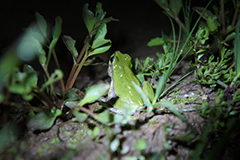
Anyone who has been near a pond or a paddy field on a warm summer evening is familiar with the loud chorus of “ribbit” sounds made by male frogs.
A study published this week by neuroscientists from the RIKEN Brain Science Institute with informatics researchers from Kyoto University and Tokyo University demonstrates that the seemingly random croaks made by groups of Japanese tree frogs are in fact carefully orchestrated.
The researchers were innovative in their approach. They combined a mathematical simulation and field observations of the frogs to study the synchronicity of their calls, something that had never been done before.
The mathematical model allowed the team to theoretically predict that the frogs would emit synchronized calls in their natural environment.
To study the frogs in the field, the team built sound-imaging devices that they called 'Fireflies', which light up when they detect a sound. They deployed Fireflies at different locations around a rice field.
They observed that neighboring pairs of male frogs alternate their calls in their natural habitats.
This research method could be applied to study the collective behavior of other animals, for example the flashing of fireflies and chirping of crickets.
The study is published in Scientific Reports DOI: 10.1038/srep03891
